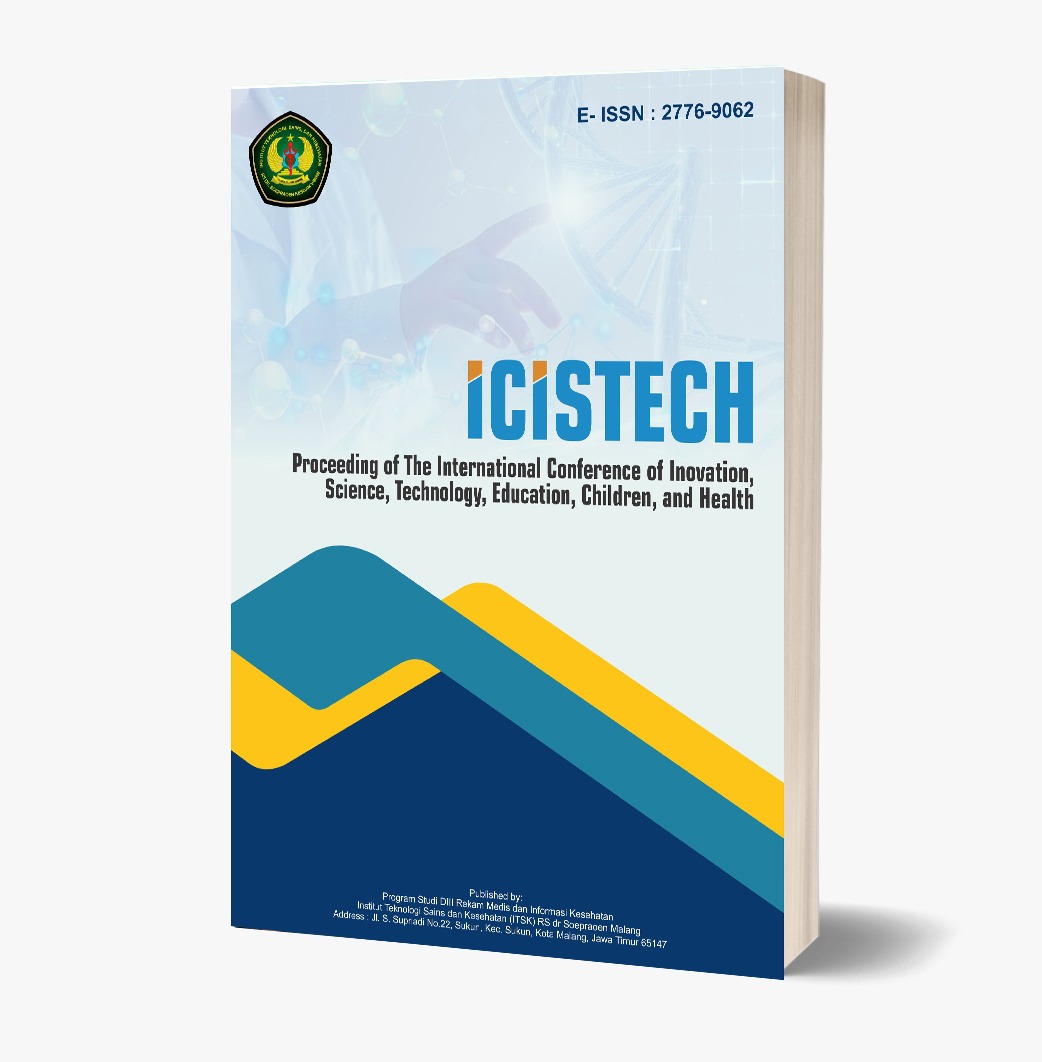A Challenge In Establishing The Etiologic Of Toxic Epidermal Necrolysis In Children
DOI:
https://doi.org/10.62951/icistech.v2i1.33Keywords:
toxic epidermal necrolysis, viral infection, drug eruptionAbstract
Background: Toxic epidermal necrolysis (TEN) is a rare especially in children, acute and potentially lifethreatening. The etiology of the higher incidence of TEN in various pediatric age groups than in adults is unclear, the cause is multifactorial. TEN have known triggering events, including infections (commonly viral or mycoplasma) drugs/herbs, malignancy, vaccines, and idiopathic. Case report: We reported a case TEN of a 5 years old boy. There was a history of fever and red rash on the patient's hands 5 days ago and taken paracetamol, amoxicilin, chlorpeniramin maleat(CTM), and vitamin C, then a red patch and blisters appears 12 hours later. Physical examination: composmentis, temperature 38,80C. Dermatological state: erythemathous macules, vesicles, bulla, erosions, excoriations, crusts on the most of body. Hyperemic conjunctiva, on oral mucosa there were erythematous oedem, erosion, excoriation and reddish-blackish crust, and erosion of the genitalia. Epidermolysis was about ± 40%. Laboratory examination :leucocyte 5300/mm3 with lymphocytosis. Serum urea increases, serum bicarbonate decreases. The patient was treated dexamethasone intra venous and decreased dose with prednisone oral, patient improved and healed on day 13. Discussion: The diagnosis of TEN in patients is made based on history and physical examination. We can establish a typical diagnosis of TEN from clinical symptoms and physical examination, but to find the etiology is sometimes difficult and requires a deep history and other investigations. The etiology in this case cannot be established because of drugs or infection. To find out, it is necessary to do further tests such as serology or PCR
References
Antoon, J. W., et al. (2018). Incidence, outcomes, and resource use in children with Stevens-Johnson syndrome and toxic epidermal necrolysis. Pediatric Dermatology, 35(2), 182-187. https://doi.org/10.1111/pde.13485
Chahal, D., et al. (2018). Vaccine-induced toxic epidermal necrolysis: A case and systematic review. Dermatology Online Journal, 24(1). https://doi.org/10.5070/D3242011185
Chowdhury, A. D., et al. (2004). Herbal medicine-induced Stevens-Johnson syndrome: A case report. International Journal of Pediatric Dentistry, 14(3), 204-207. https://doi.org/10.1111/j.1365-263X.2004.00572.x
Del Pozzo-Magana, B. R., et al. (2011). A systematic review of treatment of drug-induced Stevens-Johnson syndrome and toxic epidermal necrolysis in children. Journal of Population Therapeutics and Clinical Pharmacology, 18(1).
Demuri, G. P., et al. (2018). Dynamics of bacterial colonization with Streptococcus pneumoniae, Haemophilus influenzae, and Moraxella catarrhalis during symptomatic and asymptomatic viral upper respiratory tract infection. Clinical Infectious Diseases, 66(7), 1045-1053. https://doi.org/10.1093/cid/cix887
Fakoya, A. O. J., Omenyi, P., Anthony, P., Anthony, F., Etti, P., Otohinoyi, D. A., et al. (2018). Stevens-Johnson syndrome and toxic epidermal necrolysis: Extensive review of reports of drug-induced etiologies and possible therapeutic modalities. Open Access Macedonian Journal of Medical Sciences, 6(4), 730-738. https://doi.org/10.3889/oamjms.2018.198
Ferrandiz-Pulido, C., & Garcia-Patos, V. (2013). A review of causes of Stevens–Johnson syndrome and toxic epidermal necrolysis in children. Archives of Disease in Childhood, 98(12), 998-1003. https://doi.org/10.1136/archdischild-2013-304051
Fitriana, A., Endaryanto, A., Hidayati, A. N., Kedokteran, F., & Airlangga, U. (2018). Gambaran klinis Steven Johnson syndrome dan toxic epidermal necrolysis pada pasien anak. Periodikum Dermatologi dan Venereologi, 30(2), 102-110.
Grünwald, P., et al. (2020). Erythema multiforme, Stevens-Johnson syndrome/toxic epidermal necrolysis—Diagnosis and treatment. Journal der Deutschen Dermatologischen Gesellschaft. https://doi.org/10.1111/ddg.14009
Hamilton, G. M., & Fish, J. (2013). Pediatric toxic epidermal necrolysis: An institutional review of patients admitted to an intensive care unit. Journal of Burn Care & Research, 34(3), e351-e358. https://doi.org/10.1097/BCR.0b013e3182934d38
Koh, M., & Tay, Y. (2010). Stevens-Johnson syndrome and toxic epidermal necrolysis in Asian children. Journal of the American Academy of Dermatology, 62(1), 54-60. https://doi.org/10.1016/j.jaad.2009.01.065
Lerch, M., Mainetti, C., Terziroli Beretta-Piccoli, B., & Harr, T. (2018). Current perspectives on Stevens-Johnson syndrome and toxic epidermal necrolysis. Clinical Reviews in Allergy & Immunology, 54(1), 147-176. https://doi.org/10.1007/s12016-017-8645-8
Meyer Sauteur, P. M., Goetschel, P., & Lautenschlager, S. (2012). Mycoplasma pneumoniae and mucositis—Part of the Stevens-Johnson syndrome spectrum. Journal der Deutschen Dermatologischen Gesellschaft, 10(10), 740-745. https://doi.org/10.1111/j.1610-0387.2012.07766.x
Mockenhaupt, M., & Roujeau, J. C. (2019). Epidermal necrolysis (Stevens-Johnson syndrome and toxic epidermal necrolysis). In K. Sewon et al. (Eds.), Fitzpatrick's Dermatology in General Medicine (9th ed., pp. 733-746). New York: McGraw-Hill.
O’Brien, K. F., Maiman, R. E., & Marathe, K. (2019). Idiopathic toxic epidermal necrolysis in an adolescent. Pediatric Dermatology, 36(4), 550-551. https://doi.org/10.1111/pde.13957
Paulman, M., & Mockenhaupt, M. (2017). Fever in Stevens-Johnson syndrome and toxic epidermal necrolysis in pediatric cases. The Pediatric Infectious Diseases Journal, 36(5), 513-515. https://doi.org/10.1097/INF.0000000000001510
Spies, M., et al. (2020). Treatment of extensive toxic epidermal necrolysis in children. Pediatrics, 1162-1168.
Downloads
Published
How to Cite
Issue
Section
License
Copyright (c) 2022 Proceeding of The International Conference of Inovation, Science, Technology, Education, Children, and Health

This work is licensed under a Creative Commons Attribution-ShareAlike 4.0 International License.













